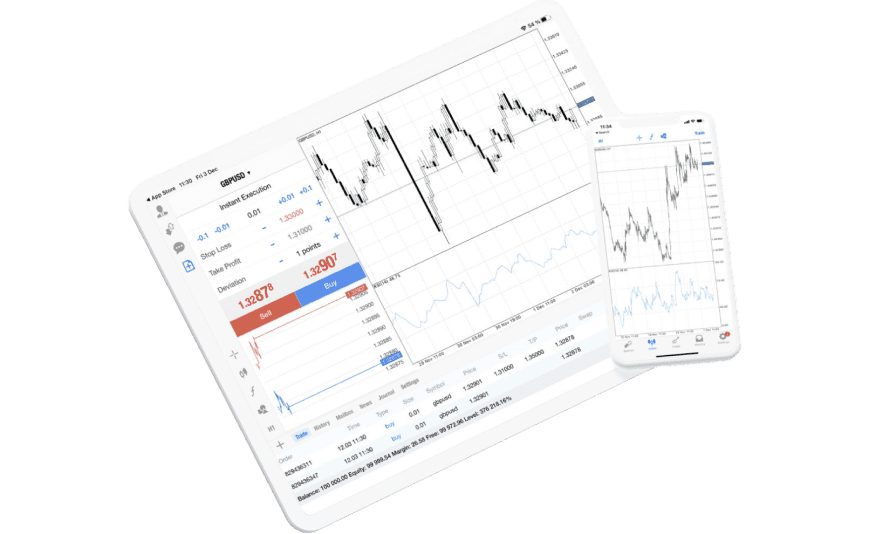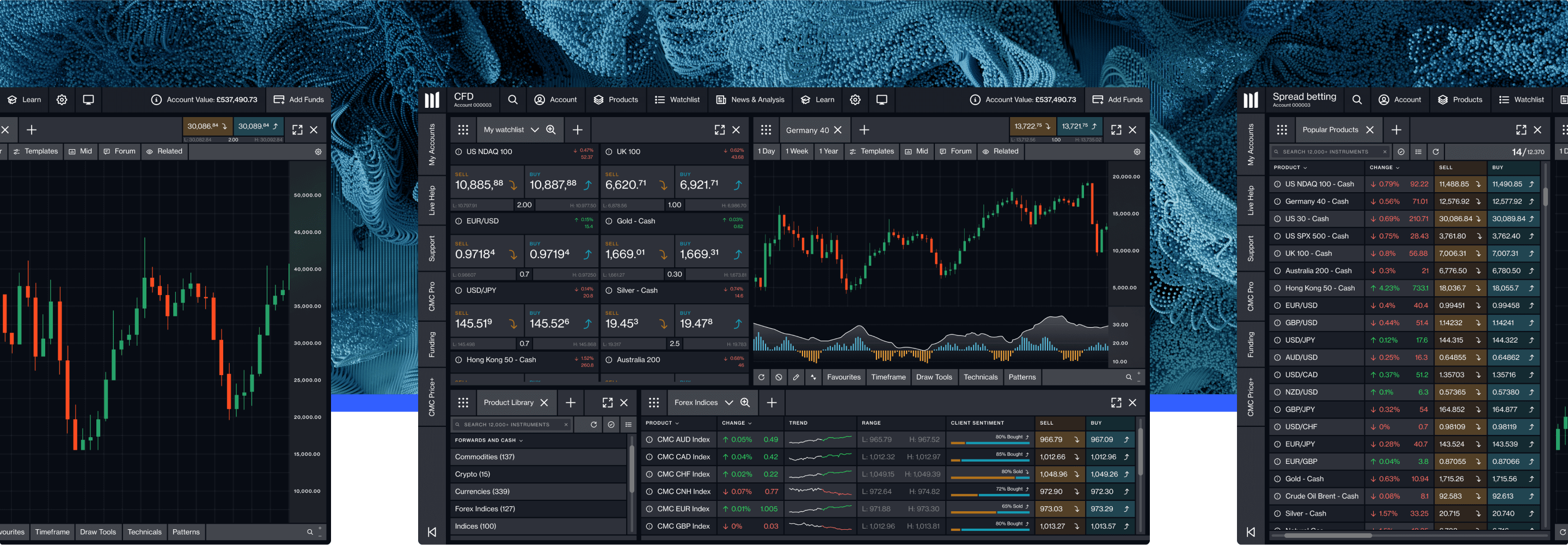Forex trading
- Trade on 300 forex pairs with leverage on our award-winning CFD platform¹
- Spreads from 0.5 pips on major FX pairs
Ultra-fast execution² with no partial fills
Experienced customer service
Open accountLog in



Ultra-fast execution² with no partial fills
Experienced customer service


ADVFN International Financial Awards
ForexBrokers.com Awards
Good Money Guide Awards
Foreign exchange (forex) trading, is the buying and selling of one currency against another, in what is the world's most actively traded market.
The forex market operates 24/5, and many traders are drawn to it because of its volatility, and the potential trading opportunities.
We combine multiple feeds from tier-one banks, to get you the most accurate bid/ask price.
Get exposure to multiple currencies in a single trade with our range of 12 forex indices.
Our experienced team is here whenever the markets are open to support you on your trading journey.
No dealer intervention – we don't reject or partially fill trades based on size.
Trade on forex, indices, commodities and cryptos
Tight spreads starting from 0.0 pips with our FX Active account
One-click trading and lighting-fast execution speeds
Customisable charts with pre-installed indicators
Automated trading with Expert Advisors (EAs)


Download MetaTrader 4 for PC or MAC and trade on the world's most popular trading platform.
A powerful trading platform designed to provide access to global markets, with advanced trading features and real-time data.
Trade on forex, indices, commodities, shares and cryptos
Tight spreads starting from 0.0 pips with our FX Active account
One-click trading and lighting-fast execution speed
More order types, timeframes, and pre-installed indicators compared to MT4
Depth of market display and inbuilt economic calendar
Experts Advisors with faster strategy tester


Download MetaTrader 5 for PC or MAC to experience its advanced trading tools and features from an industry’s leading provider.
We've invested over £100 million into our award-winning platform, creating pioneering technology to suit all trading styles.
Advanced order execution
Intuitive charting, with mobile-optimised charts
Pattern recognition scanner
Gauge market sentiment
Morningstar equity research & Reuters news

Packed with powerful features, yet intuitive, and available to all traders. Whatever the next step in your trading journey, our mobile platform can help you get there.

We've built our web trading platform to be powerful and intuitive. It combines leading-edge features and security, fast execution, and best-in-class insight and analysis. Designed to support any strategy.
INSTRUMENT | MIN SPREAD | MARGIN RATE | HOLDING COST BUY | HOLDING COST SELL |
|---|---|---|---|---|
A minimum spread is the lowest spread that will be shown on the given product. Minimum spread will vary subject to after-hours trading. If the underlying market spread widens throughout the trading day, or you're trading out of hours, the platform spread may also widen. The spreads shown are for the first price available for the average market trade/bet sizes in the relevant product. The spread will widen for larger trade/bet sizes. Please log in to our platform for more information.
INSTRUMENT | MIN SPREAD | MARGIN RATE | HOLDING COST BUY | HOLDING COST SELL |
|---|---|---|---|---|
Show more | ||||
A minimum spread is the lowest spread that will be shown on the given product. Minimum spread will vary subject to after-hours trading. If the underlying market spread widens throughout the trading day, or you are trading out of hours, the platform spread may also widen. The spreads shown are for the first price available for the average market trade/bet sizes in the relevant product. The spread will widen for larger trade/bet sizes, see our platform for more information.
INSTRUMENT | MIN SPREAD | MARGIN RATE | HOLDING COST BUY | HOLDING COST SELL |
|---|---|---|---|---|
Show more | ||||
A minimum spread is the lowest spread that will be shown on the given product. Minimum spread will vary subject to after-hours trading. If the underlying market spread widens throughout the trading day, or you are trading out of hours, the platform spread may also widen. The spreads shown are for the first price available for the average market trade/bet sizes in the relevant product. The spread will widen for larger trade/bet sizes, see our platform for more information.
INSTRUMENT | MIN SPREAD | MARGIN RATE | HOLDING COST BUY | HOLDING COST SELL |
|---|---|---|---|---|
A minimum spread is the lowest spread that will be shown on the given product. Minimum spread will vary subject to after-hours trading. If the underlying market spread widens throughout the trading day, or you are trading out of hours, the platform spread may also widen. The spreads shown are for the first price available for the average market trade/bet sizes in the relevant product. The spread will widen for larger trade/bet sizes, see our platform for more information.

CFD trading is a derivative product which enables you to trade on the price movement of underlying financial assets.
Trade on our powerful web platform and mobile app
Access key markets via the renowned MetaTrader 4 platform
Enjoy tight spreads, with no hidden fees
INSTRUMENT | MIN SPREAD | MARGIN | PRICE | HOLDING COST BUY | HOLDING COST SELL |
|---|---|---|---|---|---|
INSTRUMENT | MIN SPREAD | MARGIN RATE | PRICE | HOLDING COST BUY | HOLDING COST SELL |
|---|---|---|---|---|---|
INSTRUMENT | MIN SPREAD | MARGIN RATE | PRICE | HOLDING COST BUY | HOLDING COST SELL |
|---|---|---|---|---|---|
INSTRUMENT | MIN SPREAD | MARGIN RATE | PRICE | HOLDING COST BUY | HOLDING COST SELL |
|---|---|---|---|---|---|

A CFD account designed for forex traders, with spreads from 0.0 pips on six major FX pairs, and a fixed, low commission rate4. Plus, get a 25% spread discount on 300+ other FX pairs.
Get spreads from 0.0 pips on 6 major pairs
Enjoy a 25% spread discount on 300+ FX pairs
Access all our other markets, including indices and commodities
Trade via our proprietary web platform, intuitive mobile app or MT4
INSTRUMENT | FX ACTIVE MIN SPREAD | Standard cfd account MIN SPREAD | MARGIN RATE | COMMISSION ( PER US $100,000) | HOLDING COST BUY | HOLDING COST SELL |
|---|---|---|---|---|---|---|
0.0 | US $2.50 | |||||
0.0 | US $2.50 | |||||
0.0 | US $2.50 | |||||
0.0 | US $2.50 | |||||
0.0 | US $2.50 | |||||
0.0 | US $2.50 |
A minimum spread is the lowest spread that will be shown on the given product. Minimum spread will vary subject to after-hours trading. If the underlying market spread widens throughout the trading day, or you are trading out of hours, the platform spread may also widen. The spreads shown are for the first price available for the average market trade/bet sizes in the relevant product. The spread will widen for larger trade/bet sizes, see our platform for more information.
INSTRUMENT | FX ACTIVE MIN SPREAD | STANDARD CFD ACCOUNT MIN SPREAD | MARGIN RATE | PRICE | HOLDING COST BUY | HOLDING COST SELL |
|---|---|---|---|---|---|---|
Show more | ||||||
A minimum spread is the lowest spread that will be shown on the given product. Minimum spread will vary subject to after-hours trading. If the underlying market spread widens throughout the trading day, or you are trading out of hours, the platform spread may also widen. The spreads shown are for the first price available for the average market trade/bet sizes in the relevant product. The spread will widen for larger trade/bet sizes, see our platform for more information.
INSTRUMENT | FX ACTIVE MIN SPREAD | STANDARD CFD ACCOUNT MIN SPREAD | MARGIN RATE | SPREAD DISCOUNT | HOLDING COST BUY | HOLDING COST SELL |
|---|---|---|---|---|---|---|
25% | ||||||
25% | ||||||
25% | ||||||
25% | ||||||
25% | ||||||
25% | ||||||
25% | ||||||
25% | ||||||
25% | ||||||
25% | ||||||
Show more | ||||||
A minimum spread is the lowest spread that will be shown on the given product. Minimum spread will vary subject to after-hours trading. If the underlying market spread widens throughout the trading day, or you are trading out of hours, the platform spread may also widen. The spreads shown are for the first price available for the average market trade/bet sizes in the relevant product. The spread will widen for larger trade/bet sizes, see our platform for more information.
How do you trade on forex?
When trading forex, you speculate on whether the price of one currency will rise or fall against another. For example, if you believe that the value of the British pound will rise, relative to the value of the US dollar, you would trade the GBP/USD pair.
Markets
Forex
What is margin in forex?
To open a position you first need to deposit an amount of money known as a margin. The margin required reflects a percentage of the full value of the position. Trading on margin means you place an initial deposit, rather than the full value of the trade upfront.
The margin requirement for forex starts at 3.34%, which means you only have to put up 3.34% of the full trade value. This gives you greater exposure to your chosen financial instrument. It's very important to remember that your profits and losses will be magnified, as they're based on the full value of your trade and not just your initial margin.
Markets
Forex
What is leveraged trading?
One of the advantages of trading CFDs is that you only need to deposit a percentage of the full value of your position to open a trade, known as trading on leverage. Remember, trading on leverage can also amplify losses, so it's important to manage your risk.
Trading
Live account
Is it free to open an account?
There's no cost when opening a live trading account with us. You can also view prices and use tools such as charts, Reuters news or Morningstar quantitative equity reports, free of charge. However, you'll need to deposit funds in your account to place a trade.
New to CMC Markets
Switching to CMC Markets
Is CMC Markets regulated?
CMC Markets operates 15 offices located around the world such as the UK, Australia, Germany, Canada, New Zealand, Singapore and Bermuda. CMC Markets’ entities are licenced and regulated by the local authorities, for example, CMC Markets Bermuda is licenced to conduct investment business and digital asset business by the Bermuda Monetary Authority (‘BMA’).
New to CMC Markets
How does CMC Markets protect my money?
As a CMC Markets’ client, your money is held separately from CMC Markets’ own funds. It is held in segregated client bank accounts distributed across a range of major banks, which are regularly assessed against our risk criteria. Under the BMA rules, retail clients must be provided with negative balance protection. This means the maximum amount you can lose is what you initially deposit with us.
New to CMC Markets
How does CMC Markets make money?
Our income primarily comes from our spreads, while other fees, such as overnight holding costs, make a minor contribution to our overall revenue.
New to CMC Markets
Switching to CMC Markets
What can I trade on with CMC Markets?
New to CMC Markets


If you already have an account, log in to your chosen platform.
Don't have one yet? Open an account now.
1Best Mobile Trading Platform, ADVFN International Financial Awards 2024; No.1 Web Platform, ForexBrokers.com Awards 2023; No.1 Most Currency Pairs, ForexBrokers.com Awards 2023; Best Charting (Germany), Investment Trends Leverage Trading Report 2023; Best Customer Service (Germany), Investment Trends Leverage Trading Report 2023; Best In-House Analysts, Professional Trader Awards 2023; No.1 Platform Technology (UK), ForexBrokers.com Awards 2022; Best CFD Provider (UK), Online Money Awards 2022; Industry Pioneer with "Outstanding" Customer Rating (Germany), Focus Money Test Edition 36/2022, "Very good" Trading Platform (Germany), Deutsches Kundeninstitut (DKI) Survey 2022.
20.0040 seconds CFD median trade execution time on CMC Markets' web and mobile platforms, 1 April 2023-31 March 2024.
31.621 million unique user logins for the CMC Markets trading and investing platforms globally, as at August 2024.
4Tax treatment depends on the individual circumstances of each client and may be subject to change in the future.